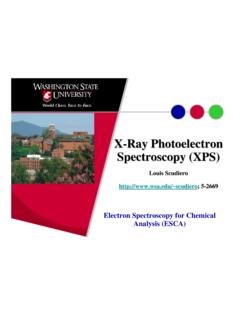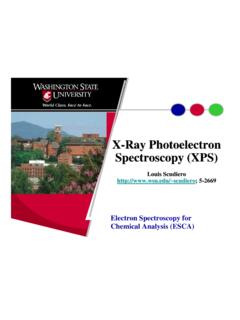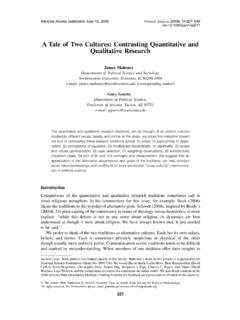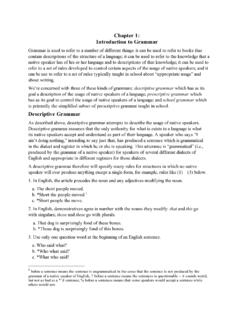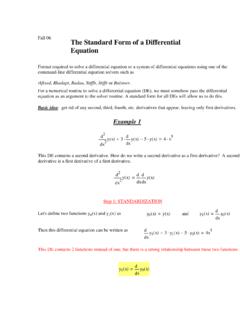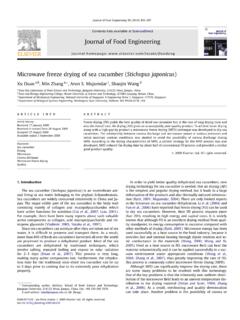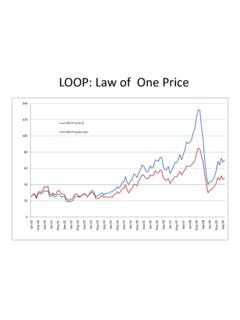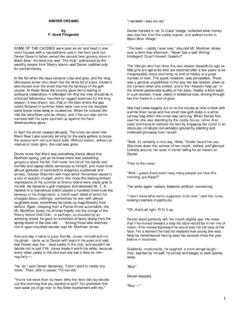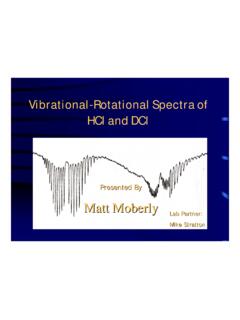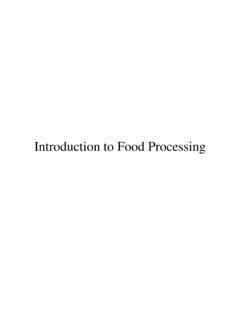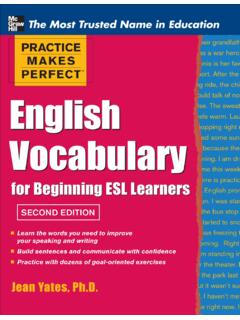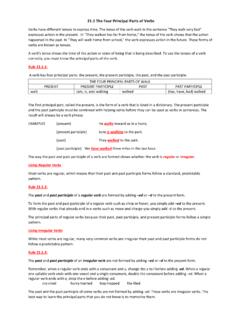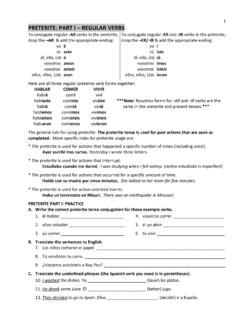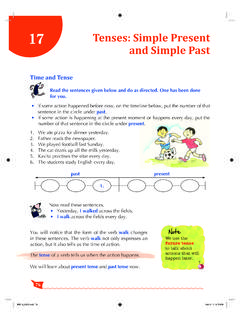Transcription of Chapter 2 Verbs and Verb Phrases Introduction
1 Chapter 2 Verbs and verb Phrases Introduction Verbs in English can be distinguished by the kinds of marking they can take and by what they can co-occur with. English Verbs all function inside verb Phrases (VPs). A simple VP consists of a lexical verb acting as the main verb of the VP and anywhere from zero to four auxiliary Verbs which are used to mark modality, aspect, and voice. (A compound VP consists of the conjunction of two or more simple VPs. Compound VPs will be discussed in Chapter 6 which deals with coordination.) VPs can be finite or non-finite. A finite verb phrase marks tense and agreement where appropriate, and has a subject which must be in the subject case if it is a pronoun1.
2 A non-finite verb phrase never marks tense or agreement; has a subject which can never be in the subject case if it is a pronoun. Verbs have a range of forms from the base (or uninflected) forms through a number of inflected forms, as illustrated in figure 1. Table 1: Forms o f English Verbs B a se Form -s form -ing Participle, present Participle Simple Past Form -ed Participle, -en Participle, Past Participle regular play play plays playing played played Irregular write write writes writing wrote written cut cut cuts cutting cut cut 1 As will be discussed in detail in Chapter 3, some pronouns in English mark what is called case.
3 In particular, for example, the personal pronoun I is used for subject and subject complements of finite Verbs , as in I like pickled beets and It is I, while me is used for objects of various kinds, as in Plckled beets please me and Pickled beets are pleasing to me and my is used for possessors, as in Pickled beets tickly my fancy. The form of many pronouns is sensitive to the role of the pronoun in the clause and if it is the subject sensitive to what kind of verb phrase (finite or non-finite and if non-finite the kind of non-finite VP) it is the subject of. The main clause of a declarative sentence2 (a statement) or interrogative sentence (a question) is always finite. A simple sentence consists of only one clause the main clause.
4 A compound sentence consists of the coordination of two or more finite clauses. A complex sentence consists of a main clause which contains at least one subordinate clause. Therefore all complete declarative or interrogative sentences contain a finite clause. We ll start by considering the structure of finite verb Phrases . Finite VPs The simplest finite VP consists of just a full or lexical verb . In the sentence The children played, played is the lexical verb , acting as the main verb of the VP; it is also the complete VP on its own. In the sentence Mary likes cheese, likes is the lexical verb , main verb , and complete VP. Notice that when the lexical verb is the only verb in the VP, then it is marked with tense and, where appropriate, agreement.
5 Tense What does tense mean? In this case, it means that you can look at the form of the Verbs played and likes and tell that the events or states conveyed in the sentences took place at different times that the children s playing took place in the past and that Mary s affection for cheese is still going on. Tense is a system of marking on the first verb of a finite VP to indicate whether the event or state held in the past or it holds in the present or future (what might be called the non-past). English has two tenses , which are traditionally called past and Agreement If the verb is in the present tense, then it will agree4 with its subject in person5 and number6: -s is suffixed (attached to the end of) to a verb which has a third person singular subject 2 A declarative sentence makes a statement, as in The moon is made of green cheese; an interrogative sentence asks a question, as in Is the moon made of green cheese?
6 ; an imperative sentence gives an order, as in Make it out of green cheese!; and an exclamatory sentence expresses an exclamation, What great cheese the moon is made out of! 3 We ll see however that the present is used to mark a range of times including the future. Notice that there is no way in English to mark a single verb to indicate an unambiguous future. Tense-marking in English is accomplished by marking the first verb in the VP. Unambiguous futures are indicated by using a modal auxiliary, will or shall, or by using semi-modal constructions like be going to. 4 Traditional grammar treats one form as changing to adjust to the presence of another form as agreement or concord: The notion here is that the verb changes to agree or be in concord with its subject.
7 We assume that the person and number of the subject in a clause is fixed--already decided by the speaker/writer, and that the form of the verb changes to agree with it in person and number. So Verbs are said to agree with their subjects; subjects are not said to agree with Verbs . 5 In English there are three persons: first person refers to the speaker or the speaker and the group that includes the speaker; second person refers to the addressee or addressees; third person refers to anyone or anything else. So for example, the first person subject pronouns are I and we; the second person pronoun is you; the third person subject pronouns are he, she, it, and they. 6 English has two numbers: singular referring to one and plural referring to more than one.
8 (so plays, likes, works, sings, tries, etc. are third person singular present tense forms of the verb ; for any other subject the unmarked or base form of the verb is used. 1. a. I play chess. b. You play chess. c. The student plays chess. 2. a. We play chess. b. You all play chess. c. The students play chess. The only exception to this rule is the verb be which is irregular and has more agreement forms than any other English verb . In the present , be has special forms for first person singular am, third person singular is, and second person and all plural7 forms are. 3. a. I am here. b. We are here 4. a. You are a fine person. b. You are fine people. 5. a. The child is happy.)
9 B. The children are happy. In the past tense, there is no agreement except again with be: The past tense form of be with a first or third person singular subject is was and with a second person or plural subject is were. The forms of be are laid out in Table 2. Table 2: Forms o f be B a se Form 1st P Singular 3rd P Singular 2nd P and Plural -ing/ present Participle -ed/-en / Past Participle Non-finite be being been present Tense am is are Past Tense was was were No other Verbs shows agreement in the past tense, regardless of whether the verb is regular like play, like, work, or try or irregular like have, sing, or cut. The past tense forms of these Verbs are played, liked, worked, tried, had, sang, and cut no matter what the subjects are.
10 6. a. I played chess b. We played chess. 7. a. Mary liked cheese. b. Mary and Louis liked cheese. 8. a. The child worked hard. b. The children worked hard. 9. a. The class tried something new. b. The class members tried something new. 10. a. I had a bad day. b. We had a bad 11. a. Ms. Brown sang badly. b. Ms. Brown and the entire faculty sang badly. 12. a. I cut the cards for the magician. b. We cut the cards for the magician. 7 There is a clear historical reason why second person and plural forms trigger the same agreement: As we will discuss when we talk about pronouns, historically you is a plural form (and it has absorbed the singular function as well as the plural).
